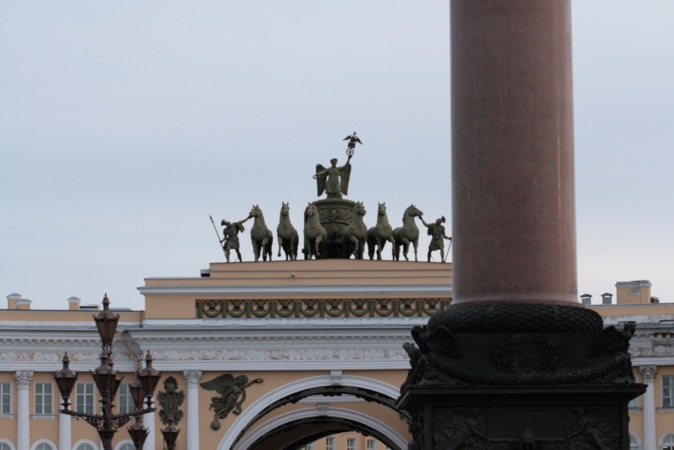Alexander Column (Alexandria Pillar)
The column on Palace Square is a striking and at the same time quite simple triumphal structure.
The column was designed by architect Montferrand by order of Tsar Nicholas I, who wanted to perpetuate the victory of Alexander I in the battle with Napoleon Bonaparte. An interesting fact is that initially it was planned to install an obelisk, but the project was not approved. To strengthen the foundation, more than a thousand wooden piles six meters long were driven into the soil. A box filled with commemorative coins is mounted in the center of the foundation. In 1834, the structure was installed in the middle of the square, and in honor of this event, a parade of one hundred thousand troops led by the emperor took place.
The height of the pink granite structure was 47.5 meters, and its weight was 600 tons. It is precisely due to its impressive mass and thanks to the architect's precise calculations that the Pillar of Alexandria has been standing reliably in place for almost 200 years, not fixed or supported by anything. During all this time, the foundation of the structure has never shrunk or deviated from the vertical. The installation took a little more than an hour and a half, and about two and a half thousand people took part in the work. The column was polished and processed for another two years. The material was brought from the Pyuterlak quarries near Vyborg.
Legend has it that citizens were afraid to walk near the column, having learned that it was not fixed. To assure people of the reliability of the building, architect Montferrand walked around the column every morning for the rest of his life. This architectural structure survived the bombing during the war, despite the close proximity of the explosion of shells.
The column is crowned by an angel statue designed by Boris Orlovsky. In his left hand, the angel holds a cross, and the right hand faces the sky. The bas-reliefs of the pedestal depict an arsenal of weapons and armor, and the pedestal itself is decorated with ornaments. The uniqueness of the design lies in the fact that the metal rod that attached the figure to the column was subsequently accidentally removed. It turns out that the statue is held by its weight, just like the column itself.
This unique building, located in the very center of Palace Square in St. Petersburg, impresses with its grandeur and beauty. You can admire the Alexandria Column from the Moika embankment and Bolshaya Morskaya embankment, through the arch of the General Staff Building, but it's better to get a closer look and see everything in detail.
Address
Dvortsovaya Square.
Address
Dvortsovaya Square.
Address
Dvortsovaya Square.
Website
Alexander Column (Alexandria Pillar)
Website
Alexander Column (Alexandria Pillar)
Website
Alexander Column (Alexandria Pillar)
Source
https://kudago.com/spb/place/aleksandrovskya-kolonna/
Source
https://kudago.com/spb/place/aleksandrovskya-kolonna/
Source
https://kudago.com/spb/place/aleksandrovskya-kolonna/


